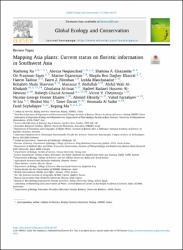Mapping Asia plants: current status on floristic information in Southwest Asia

View/
Access
info:eu-repo/semantics/openAccessDate
2020Author
Xu, XuehongNaqinezhad, Alireza
Ghazanfar, Shahina A.
Fragman-Sapir, Ori
Oganesian, Marine
Kharrat, Magda Bou Dagher
Taifour, Hatem
Özcan, Taner
Metadata
Show full item recordAbstract
Mapping Asia Plants (MAP) is a comprehensive project that aims to build a detailed infrastructure for integrating Asian plant distribution data a global-scale array of knowledge for plant biodiversity conservation. Here, we provide a brief historical review of botanical research in Southwest Asia an understudied botanical region with high conservation priority. Nineteen countries were included in this study (from west to east): Turkey, Cyprus, Palestine, Israel, Jordan, Saudi Arabia, Lebanon, Syria, Iraq, Georgia, Yemen, Armenia, Iran, Azerbaijan, Kuwait, Bahrain, Qatar, United Arab Emirates, and Oman. We reviewed 132 resources comprising 125 Floras and Checklists, of which we describe in some detail at least one of the most important Floras or Checklists for each country. Complete and published national Floras exist for 13 countries; three countries (Jordan, Israel and Bahrain) do not have a Flora but have annotated Checklists, and national Floras are at different stages of completion for Iran, Iraq and Georgia. Where present, online resources are also given for references. We found major gaps in species concepts and taxonomic classification systems, and that many up-to-date Flora revisions remained unresolved, i.e. taxon ranks and species concepts varied among different countries, different systems were adopted or followed in the taxonomic treatments in the Floras and Checklists, and some of the current Floras are out of date. Floras are the first necessary step for many fields, including evolutionary biology, ecology, biogeography, and systematics, as well as environmental research and conservation of biodiversity at national and international levels. Here, we provide the progress updates on the main published floristic works of Southwest Asia, which continue to serve as references for the Flora of Southwest Asia, and will be the foundation of the MAP project.

















